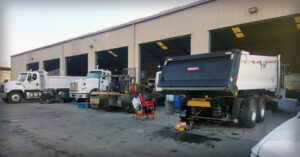Hauling Industry News
Truck Tarp Repair: Finding a Trustworthy Service Center
 Your automated tarping system is one of the most critical safety components of your truck’s setup. The system is responsible for securing the load and ensuring protection and control of materials during transport. It also keeps other drivers and pedestrians on the road safe by preventing material or debris from flying out while driving.
Your automated tarping system is one of the most critical safety components of your truck’s setup. The system is responsible for securing the load and ensuring protection and control of materials during transport. It also keeps other drivers and pedestrians on the road safe by preventing material or debris from flying out while driving.
Fleet managers and owner-operators must maintain their system and truck tarp to achieve optimal performance and safety. There are numerous ways that a truck tarp can become damaged throughout its life. Loading and unloading materials, sharp debris in the bed, wind whip, and improper fitting place your tarp at risk of becoming inoperable.
Frequent inspections of the system and truck tarp for damage or early indicators of wear and tear are essential. By staying on top of your tarp’s overall integrity, you can reduce downtime for repairs and prevent damage and replacement of other tarp system components while maintaining steady profitability.
Having a reliable service center you can trust at the first sign of any issue or tarp damage is a necessary step toward staying on the road and out of the garage. In this article, we’ll explore how to find a trustworthy truck tarp repair service center.
Common truck tarp and tarp system issues
Fleet companies and owner-operators understand that equipment will need maintenance and repairs with prolonged use. Tarps and tarping systems can sustain damage from loading and unloading events or other roadside accidents. Some frequently encountered issues include:
Rips and tears in your truck tarps from extended use, sharp material loads, wind whip, heavy repeated use, or UV overexposure
Torn tarp pockets or grommets at attachment locations resulting from loading/unloading operation, operator holding tarp switch too long, or contact to overhead obstacles while tarping and driving
Torsion spring wear can reduce tarp arm tension over time causing uneven tarp operation
Improper or damaged electrical components or wiring can cause tarp motor malfunction or resulting in premature damage
Finding a reputable truck tarp repair service center
When you notice performance issues or the initial signs of damage, it’s imperative that you seek out a reputable truck tarp repair service center. Getting ahead of problems before they cause further tarp system issues will save you time and money. When searching for a reputable service center, consider the following:
- Service technicians: Ensure your service center has highly qualified service technicians. Poor training or a lack of credentials may ultimately keep you out of service longer.
- Quality parts: Verify that the service center uses replacement parts from the OEM. Regarding tarps, premium materials and state-of-the-art manufacturing techniques produce the highest quality finished fabrics for a longer tarp life for less frequent tarp swap outs and greater ROI.
- Strong warranty: Explore if the service center offers warranties on parts or their work. This can be helpful if you continue to experience issues.
- Positive reviews: What do other drivers say about a particular service center? Be sure to read reviews on a prospective service center before making an appointment.
- Complimentary inspections: Not all repair centers offer this service, but it’s a great value-add feature that can help you better understand their offerings and help you better diagnose your tarping issues.
Practice damage prevention
By pre-qualifying potential service centers, you’re taking the first steps toward streamlining the repair process. It’s also smart to implement preventive measures that will keep your truck or fleet production moving forward. Here are some damage prevention best practices to consider:
- Training for drivers and loaders: Truck drivers and loaders should be trained on damage prevention for your specific hauling application. Understandably, these best practices will vary for different tarp materials, tarping systems, and hauling needs.
- Know your load: Always consider what you’re hauling to determine the right tarp for your truck or trailer. If you equip your truck with a tarp or tarp system that isn’t suitable for your load, you will set yourself up for future issues.
- Mitigate wind whip: Wind and airflow are important considerations for the lifespan of your tarp. Taking a few extra moments to ensure your tarp is taut and adequately secured will reduce damage from wind whip.
- Learn system functions: Make sure every driver in your fleet understands the core functions of your tarping system and how to operate it properly. You’ll be able to diagnose in-field problems better and find solutions with little delay.
Find a reputable service center
Tarp repairs are often inevitable but taking time to pre-qualify potential service centers will save you stress, time and money. Remember that staying on the road starts with understanding common issues like signs of overuse or motor fatigue. When you run into challenges with your tarp and tarping system, consider one of Roll·Rite/Pulltarp’s Safe Fleet service centers. Our service and repair facilities are located throughout the United States to ensure you get back on the road quickly and safely. Roll·Rite and Pulltarps, Safe Fleet Brands, also has an extensive network of authorized distributors offering tarp repairs and upfitting you can explore with our online dealer locator or by contacting our manufacturing headquarters.